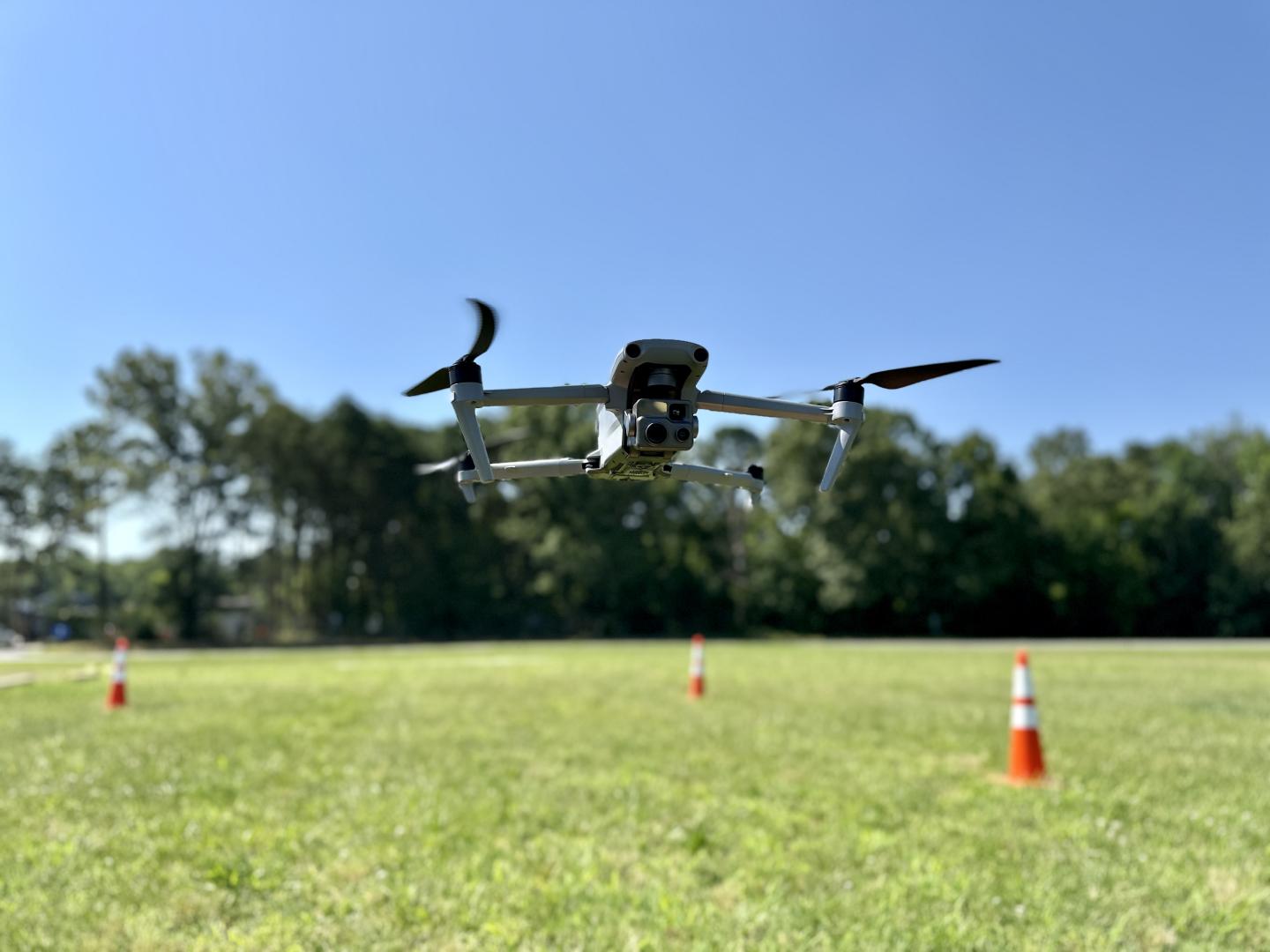Program Expansion
The Anne Arundel County Police Department is announcing the expansion of its existing UAS/drone program to include a pilot study of the use of UAS/drones during patrol response to calls for service.
Our existing use of drones has already proven invaluable in motor vehicle crash investigations, allowing us to map fatal scenes with pinpoint accuracy and significantly reduce road closure times. As the technology evolves, so do the use cases. More and more agencies in the surrounding area use them for officer safety, sending a drone into spaces where it could be dangerous for a human, but information was imperative to obtain safely.
As this evolution began to take shape, the department initiated a more focused effort to explore the program's potential, engaging with neighboring agencies and meeting with vendors to determine how the technology could enhance our community's safety efforts.
As a result, the department elected to pilot drones in a patrol capacity, allowing officers responding to active calls to simultaneously deploy drones for a faster and more efficient scene overview. This enables them to manage resources efficiently and enhances officer safety.
-
 UAS/Drone-Related Activity Dashboard
UAS/Drone-Related Activity DashboardThis dashboard provides a comprehensive overview of patrol led UAS/Drone operations.
Flight data will appear no sooner than 30 days following the flight. -
 Annual Reports
Annual ReportsAnnual reports on UAS/Drone deployment and use will be published annually, beginning in 2026.
-
 Success Stories
Success StoriesThe following examples illustrate how the Patrol Drone Program significantly enhances officer response to critical incidents.
Success Stories coming soon.
Mission
The Anne Arundel County Police Department’s Uncrewed Aircraft System (UAS)/Drone Program is only used for public safety purposes and missions:
- To provide situational awareness during planned and unplanned events, calls for service, and investigation of criminal activity to assist officers and decision makers in understanding the nature, scale, and scope of an incident affecting public safety and for planning and coordinating an effective and safe response.
- To provide visual observations during search and rescue missions for missing and at-risk persons, and similar incidents.
- To minimize risk and increase safety to officers, victims, members of the community, and suspects by providing visual observations during high-risk law enforcement operations and incidents.
- To document crime scenes, traffic crash scenes, or other incident scenes (e.g., disaster damage assessment, etc.).
The Anne Arundel County Police Department’s UAS/Drone Program is NOT used for:
- Random surveillance or random patrols.
- Collecting, disseminating, or retaining recorded images, sounds, video, or other data for the sole purpose of monitoring constitutionally protected activities.
- Collecting, disseminating, or retaining recorded images, sounds, video, or other data solely based on individual, constitutionally protected characteristics of a person. Anne Arundel County Police Department UAS/Drones are not equipped with weapons of any kind.
Key Advantages
- Faster Emergency Response: UAS/Drones provide immediate aerial views, enabling a quicker and more targeted response, and delivering help where it's needed faster.
- Enhanced Safety for All: By offering an elevated aerial perspective, UAS/drones can help officers de-escalate dangerous situations, protecting both our community members and our police officers.
- Swift Searches: UAS/Drones can rapidly locate missing persons or suspects, bringing quicker resolutions and peace of mind.
- Optimized Police Operations: This technology enables the police department to maximize effectiveness, ensuring that resources are deployed strategically and officers are available for critical calls.
- Reduced Traffic Delays: For incidents such as serious crashes, UAS/drones can quickly map and visually document the scene, minimizing road closure times and easing traffic congestion for the public.
- Special Events: UAS/Drones enhance the ability of officers and public safety leaders to effectively manage traffic and crowds attending public special events, ensuring everyone’s safety.
- Integration with Real Time Information Center: Police Department UAS/Drones have the capability to transmit video and images to the police department’s Real Time Information Center, further enhancing the ability to respond to public safety incidents in an efficient and safe manner.
Privacy, Transparency, and Accountability
- The police department will provide public notice of planned UAS/Drone operations, except when such notice may compromise the safety of any person or may impede the purpose of the UAS/Drone operation.
- UAS/Drone flight documentation is audited on a quarterly basis.
- An annual report is published and made publicly available, documenting the police department’s deployment and use of UAS/Drones.
- The police department’s UAS/Drone policies are reviewed annually to assess the need for updates, ensuring that privacy, civil rights, and civil liberties are protected.
- Recorded images, sounds, video, or other data may only be collected through the use of a UAS/Drone for official law enforcement and public safety purposes.
- Recorded images, sounds, video, or other data that have evidentiary value are handled in accordance with statutory and constitutional law, as well as the police department's policies related to the collection and storage of evidence.
- Information, digital media, data, and records obtained or created as part of the police department’s UAS/Drone Program are considered police department records to be retained under the police department’s records retention policy and are protected by the Maryland Public Information Act (MPIA). Such records may only be disseminated with approval by the police department’s custodian of records in accordance with the MPIA, police department policies, and Maryland Court Rules (if applicable).
- Recorded images, sounds, video, or other data that have no evidentiary value will not be retained for more than 30 days.
- All police department personnel involved in the UAS/Drone program must comply with all relevant laws and regulations, police department rules, written directives, and standard operating procedures.
- All complaints of police misconduct related to the use of UAS/Drones, including misconduct related to data gathered through the use of UAS/Drones, must be handled in accordance with relevant disciplinary statutes, regulations, and department policies.
- The police department’s UAS/Drone policy (Index Code 1840) is publicly available via the following link: https://public.powerdms.com/AAC/tree/documents/3843547
Police Department UAS Pilots
- UAS/Drone Pilots are designated and approved by the police department’s UAS/Drone Coordinator.
- UAS/Drone Pilots may only operate UAS/Drones consistent with Federal Aviation Administration regulations and police department policies and standard operating procedures.
- UAS/Drone Pilots must complete and maintain training as required by the police department’s Special Operations Division.
- UAS/Drone Pilots must maintain good standing with appropriate Federal Aviation Administration certifications applicable for the UAS/Drones they have been authorized to operate.
- UAS/Drone Pilots are responsible for maintaining and ensuring the equipment assigned to them is in safe operational condition.
Frequently Asked Questions
Building on over a decade of specialized use, our department is now expanding our drone program to support daily patrol operations and calls for service to increase public safety. This technology provides critical situational awareness for a faster, safer response and will be deployed under strict policies that protect citizen privacy.
The AACPD aims to leverage advanced technologies, including drones, to detect, connect, and protect the community. This involves improving real-time situational awareness, fostering seamless communication and collaboration, and ultimately safeguarding both officer and community safety. Drones assist in providing critical information to officers and enhancing crime prevention and investigation efforts.
AACPD utilizes drones for legitimate law enforcement purposes, which may include:
- Scene Documentation - Example: Fatal/Serious Crash reconstruction investigations.
- Situational Awareness - Example: Responding to Active Calls for Service.
- Assisting in criminal investigations.
- Addressing public safety threats.
- Authorized training exercises.
- Search and rescue operations (as seen in other Maryland counties).
- Providing aerial support for tracking suspects or stolen vehicles (as seen in recent AACPD activity).
No. The AACPD explicitly states that its systems, which would include drones, are used solely for legitimate law enforcement purposes such as active calls for service, criminal investigations, public safety threats, scene documentation, and authorized training. They are not intended for routine monitoring or proactive patrolling of areas for general surveillance.
Protecting privacy and civil liberties is paramount to the AACPD. Our program operates under clear guidelines and oversight mechanisms to prevent misuse of technology. Key safeguards include:
- No Facial Recognition: Our drones do not utilize facial recognition technology in any video feeds, including those captured by drones.
- No Routine Monitoring: The department does not routinely monitor shared community video or use drones for general, pervasive surveillance.
- Legitimate Law Enforcement Purposes Only: All drone operations are conducted ethically and lawfully for specific, legitimate law enforcement purposes.
Yes. To operate drones as a government employee (for a police or fire department) in Maryland, individuals must either operate under the Federal Aviation Administration's (FAA) Part 107 rule or obtain a federal Certificate of Authorization (COA). This requires passing the FAA's Aeronautical Knowledge Test to obtain a Remote Pilot Certificate. Additionally, department drone pilots attend a 32-hour in-house introductory drone operations course before being issued a drone for patrol deployment.
Yes, like all drone operators, the AACPD must adhere to FAA regulations. This includes obtaining airspace authorizations, particularly when operating within a certain distance of airports like BWI Marshall Airport and Martin State Airport.
Contact
If you have questions about the UAS/ Drone Program, please contact our Special Operations Division's UAS/Drone Program Coordinator at pd-droneteam@aacounty.org.
